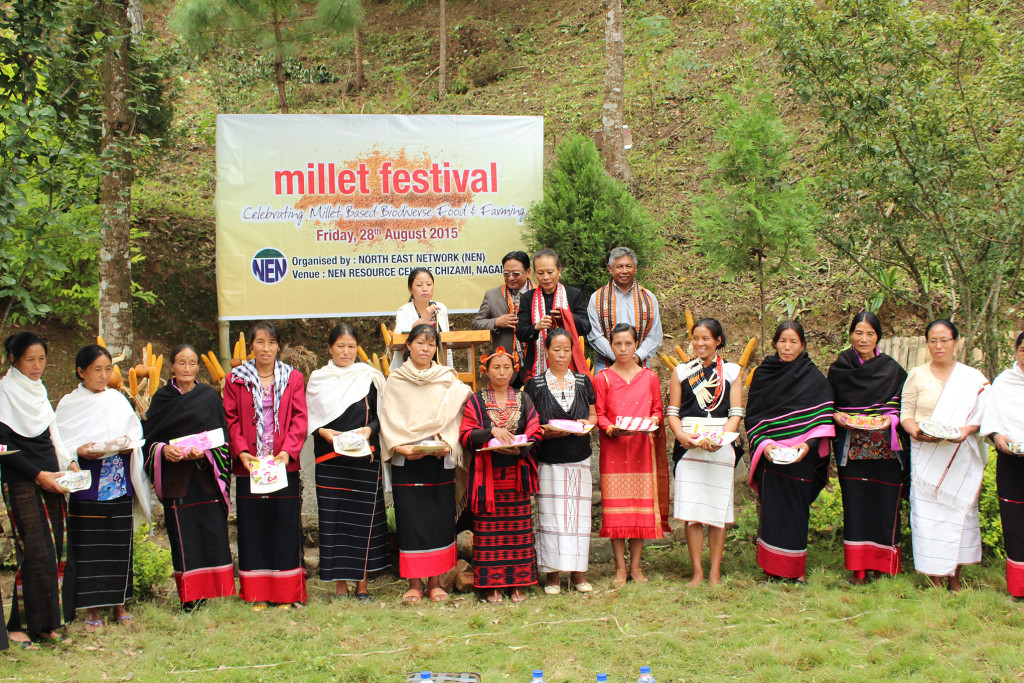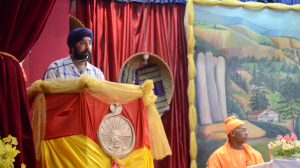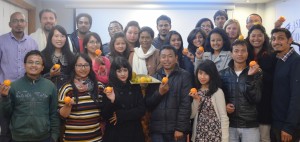NESFAS has been working in close collaboration with North East Network with many common objectives, notably encouraging sustainable practice of millet farming in the indigenous communities of North East India. Understanding the importance of celebration in indigenous farming, NESFAS delegation both attended and participated in the festival.
The timing of the festival coincided with Dr Fransisco’s visit to NESFAS, so he joined the delegation to present the values of agroecology at the event, and to visit the farming communities of Chizame.
The NESFAS delegation included Dr Fransisco Rosado May, Mexico; Ms. Anna-Louise Meynell, Weave Consultant NESFAS; Ms. Sanamika; Ms. Siltidora Shyrkon, Millet farmer, West Khasi Hills; Ms. Binasi Swer, Millet farmer, East Khasi Hills, Mr. Marcus Rani, Driver, NESFAS and Mr. Rupam, Driver, NESFAS.
The festival was hosted by Wekoweu Tsuhah program manager, NEN, who eloquently introduced the festival and the program of speakers. It began with a blessing from Mrs Eyiekhrou Kenye, a female pastor of the Zapami Baptist Church.
Seno Tsuhah (team leader of NEN), gave an introduction to the festival, presenting millet as the future of sustainable agriculture. “Climate change is here, climate change is affecting us the globe over and millet – also known as the ‘poor man’s food’- is a good and healthy substitute to rice. It is a robust crop that is low cost, has high yield and grows in most types of soil”, she said in her speech.
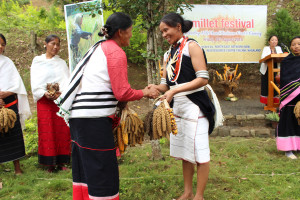
The festival showcased some of the traditional farming songs of the local villages, from both men and women’s singing groups. Songs and celebration are deeply integrated into the cycle of millet production and the rhythm of the songs reflected beautifully the village farming practices, as Enyipelo Thopi narrated in his speech on the harvest festival practices.
Shri Hewoto Sema gave a short introduction to the Phek District, and the characteristics of the landscape and farming practices.
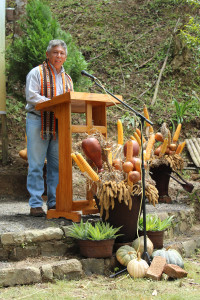
Dr Francisco Rosado May gave a presentation on the theories of agroecology, congratulating the farmers on their biodiverse farming practices, highlighting the similarities of indigenous communities across the world. He spoke of the powerful blend of intercultural knowledge sharing, and the potential of indigenous knowledge combined with science. He emphasised the important role that women have to play in farming, seed keeping and in pushing men to think for alternatives to pesticides. His comments resonated particularly well with the indigenous communities, as was commented afterwards.
Smti Banuo Jamir was invited to honour selected farmers for their commitment to millet farming, Binasi Swer from East Khasi hills was among the farmers receiving recognition.
Siltidora, one of the millet farmers in NESFAS delegation gave a speech of solidarity, reflecting on her personal experiences with millet in her village in West Khasi Hills in Meghalaya. A farmer from the local naga community followed with her personal message of solidarity.
Anna-Louise Meynell gave a presentation on the Indigenous Terra Madre 2015 conference, and the opportunity that it will present to showcase the diverse culture, food and farming practices of the North East of India.ndige
Finally the guest of honour Shri Alemteshi Jamir, former Chief Secretary of Nagaland gave a speech that reinforced the role of millet in adapation to climate change, with variation in food production likely to reach 17%. He encouraged the growth of festivals such as this, to promote the local biodiversity of the region on a larger platform.
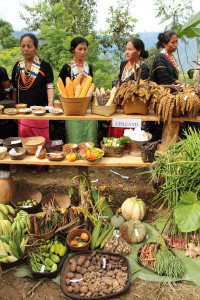 The remainder of the afternoon was an opportunity to study the display of biodiversity of the village products, as the farmers laid out the produce. There was an active period of exchange and sales until the closure of the event.
The remainder of the afternoon was an opportunity to study the display of biodiversity of the village products, as the farmers laid out the produce. There was an active period of exchange and sales until the closure of the event.
Later in the day the group visited the Chizame Weaves centre, and saw the display of traditional backstrap loom products. The centre provides a framework for orders and product development, with the artisans receiving raw material and then weaving at home. Chizame Weaves has seen considerable success over the 10 years it has been operating. Dr Fransisco and Anna-Louise discussed the importance of understanding the market potential, and the limits, at what point does the market level out.
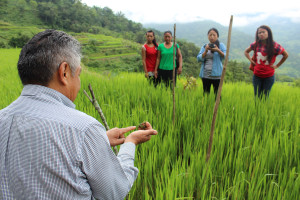 The second day of the stay in Chizame was packed full of field visits and interaction with local farmers and artisans. Beginning with a walk amongst the paddy fields, sharing indigenous knowledge, agroecological farming practices and local myth and legend. Dr Fransisco passed on a wealth of knowledge to the NEN team and the farmers, much of which will be implemented into the farming practices of those present. He showed the group how the tall traditional corn plants are folded over at the top of the stem just as the corn becomes ripe, to prevent rain destroying the corn and birds eating it before it is ready to be harvested. He pointed out algae in the rice paddy’s that indicated a healthy paddy field. Coming back to corn as we passed further plants, he demonstrated how to excel the fertilising of corn plants, producing a faster method of cross-fertilization of different corn species. Throughout each of the field visits, he congratulated the farmers on the successful biodiverse nature of the fields, with as many as 8 crops growing together in the same areas.
The second day of the stay in Chizame was packed full of field visits and interaction with local farmers and artisans. Beginning with a walk amongst the paddy fields, sharing indigenous knowledge, agroecological farming practices and local myth and legend. Dr Fransisco passed on a wealth of knowledge to the NEN team and the farmers, much of which will be implemented into the farming practices of those present. He showed the group how the tall traditional corn plants are folded over at the top of the stem just as the corn becomes ripe, to prevent rain destroying the corn and birds eating it before it is ready to be harvested. He pointed out algae in the rice paddy’s that indicated a healthy paddy field. Coming back to corn as we passed further plants, he demonstrated how to excel the fertilising of corn plants, producing a faster method of cross-fertilization of different corn species. Throughout each of the field visits, he congratulated the farmers on the successful biodiverse nature of the fields, with as many as 8 crops growing together in the same areas.
The group then visited a seed keeper in the village of Sumi, who showed us millet seeds that had been stored for over 30 years, still in perfect condition. This highlighted the important role many women take on in safeguarding the longevity of a diverse range of crops.
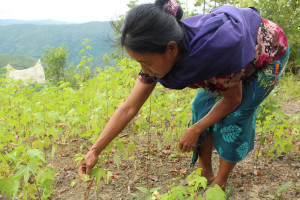
From Sumi, they moved on to the jhum fields, where the visitors saw again the successful diverse nature of the crops, with corn, beans, tomatoes, brinjal, cucumber, chilli and cotton sharing the same fields. It was interesting to learn of the cotton cultivation in some communities, with the women then spinning and weaving the cotton for small-scale production of entirely local and organic cotton fabric. While he did evaluate the crops to be in good health, Dr Fransisco drew our attention to a couple of pests in the crop. Aphids were present on one or two plants, causing the leaves to curl up. There were also small worms in some leaves, causing the leaf to fold over onto itself. The biodiversity of crops is the natural alternative to pesticides, which has safeguarded the majority of the crop.
The following day the team returned to Shillong, marking the end of Dr Fransisco’s much-appreciated visit to North East India.
Reported by Anna-Louise Meynell

